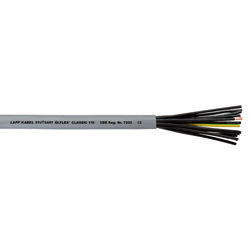LAPP Power Cables (Conductor Cross Section: 2.5)
Key Considerations When Choosing Power Cables
Power cables are essential components that transmit electrical energy from a power source to various devices and appliances. They are typically composed of one or more conductors, usually made of copper or aluminum, surrounded by insulation to prevent electrical shock.
- Voltage: Voltage rating: Ensure the cable's voltage rating matches the device or appliance you're powering. Amperage rating: The cable should be able to handle the required amperage without overheating. Check the device's specifications for this information.
- Amperage: The cable should be able to carry the required amperage without overheating.
- Length: Sufficient length: Choose a cable that is long enough to reach your device without excessive strain or extension cords. Avoid excessive length: Longer cables can lead to increased voltage drop and power loss.
- Durability: Consider the cable's jacket material, which protects the inner conductors. Choose a material suitable for the environment where the cable will be used (e.g., indoor, outdoor, harsh conditions).
- Safety: Look for safety certifications such as UL (Underwriters Laboratories) or ETL (Intertek ETL) to ensure the cable meets safety standards.
Advantages of buying from MISUMI
- Wide selection: MISUMI offers a wide range of power cables, including various types, gauges, and lengths.
- Customizable options: You may be able to customize certain cables to meet your specific needs.
- High quality: MISUMI is known for its commitment to quality, and their power cables are likely to be reliable.
- Competitive pricing: MISUMI may offer competitive pricing on their products.
- Excellent customer service: MISUMI provides excellent customer support, including technical assistance and after-sales service.
- Keyword Selected :
- Brand: LAPP
- Conductor Cross Section: 2.5
- Compare
 Power and Control Cable, ÖLFLEX CLASSIC 110 SeriesPower and Control Cable, ÖLFLEX CLASSIC 110 SeriesLAPPFrom :฿ 6,372.004 Day(s)
Power and Control Cable, ÖLFLEX CLASSIC 110 SeriesPower and Control Cable, ÖLFLEX CLASSIC 110 SeriesLAPPFrom :฿ 6,372.004 Day(s)
FAQ Power cable
- Question: What is the purpose of a power cable?
- Answer: A power cable is used to transmit electrical power from a power source to various devices or equipment. It serves as a conduit for delivering electrical energy, allowing appliances, machinery, and systems to function.
- Question: What are the different types of electrical power cables?
- Answer: There are various types of electrical power cables designed for different applications.
1. VCTF cables are flexible power cables commonly used for indoor electrical wiring. They have a vinyl insulation and are suitable for connecting appliances and devices.
2. VCT cables are similar to VCTF cables but are designed for heavier-duty applications. They are often used in industrial settings and offer increased durability and resistance to abrasion.
3. VFF cables, also known as flat cords, are thin and flexible cables commonly used for small appliances and devices. They are typically used for low-power applications and have a flat profile for easy installation in tight spaces.
4. VCTFK cables are heat-resistant power cables designed for use in high-temperature environments. They have a fluorine resin insulation and can withstand elevated temperatures, making them suitable for industrial applications.
5. IV cables, or insulated wires, are single-core cables with various insulation materials. They are used for internal wiring in electrical equipment and appliances. - Question: What are some common types of power cables and why is it important to choose the right type for specific applications and environments?
- Answer: There are several types of power cables available, each designed for specific applications and environments. The exact number of types may vary depending on factors such as voltage rating, insulation materials, and specific industry requirements. Common types of power cables include, PVC Cables, XLPE Cables, Flexible Cables, High Voltage Cables. These are just a few examples, and there may be other specialized types of power cables available based on specific requirements. It is essential to choose the right type of power cable based on factors such as environmental conditions for safe and efficient power transmission.
- Question: Are power cables designed for AC or DC power transmission?
- Answer: There are several types of power cables available, each designed for specific applications and environments. The exact number of types may vary depending on factors such as voltage rating, insulation materials, and specific industry requirements. Common types of power cables include, PVC Cables, XLPE Cables, Flexible Cables, High Voltage Cables. These are just a few examples, and there may be other specialized types of power cables available based on specific requirements. It is essential to choose the right type of power cable based on factors such as environmental conditions for safe and efficient power transmission.
Chat with MISUMI
Chat service is available for any inquiry to MISUMI
Service hours
9:00 - 18:00 (Mon-Sat)
For out of service hours, you can leave a message to us.
We will reply to your inquiries on the next business day.
(except Sundays and public holidays).
Noted for use
Chat service is for Corporate customers and limited for Thai language.
Request for Quotation and Place Order is not available on Chat.
This Website uses cookies. Please accept our cookie policy for your best experience.
You can learn more on how to adjust your cookie setting in our Privacy Policy here



